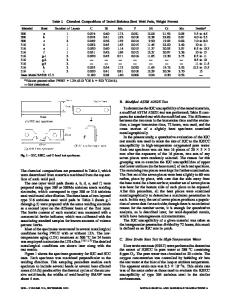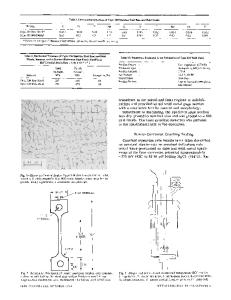Stress Corrosion Cracking Behavior at Inconel and Low Alloy Steel Weld Interfaces
- PDF / 6,133,962 Bytes
- 15 Pages / 593.972 x 792 pts Page_size
- 22 Downloads / 358 Views
I.
INTRODUCTION
STRESS corrosion cracking (SCC) has been a serious issue regarding safe operation of nuclear power plants.[1–4] Although a considerable number of studies has been reported, the underlying mechanism is still not well understood. As for boiling water reactors (BWR), in 1970s the SCC in austenitic stainless steel pipe welds and components made of nickel base alloys (so-called ‘‘Inconels’’) became a serious generic problem for BWRs. After the worldwide extensive studies, the main materials factor for the SCC was widely recognized as sensitization (the formation of grain boundary Cr depletion). Various countermeasures for SCC of this type have been developed and implemented.[5,6] However, recently SCC crack initiation and propagation in components such as core shroud support made of Inconels and primary loop recirculation piping and core shroud made of SCC resistant low carbon stainless YO TOMOTA, Professor, is with the Graduate School of Science and Engineering, Ibaraki University, 4-12-1 Nakanarusawa, Hitachi, Ibaraki 316-8511, Japan. Contact e-mail: [email protected] SHIN DAIKUHARA, Graduate Student, is with the Ibaraki University, 4-12-1 Nakanarusawa, Hitachi, Ibaraki, 316-8511 Japan. SHUN NAGAYAMA, formerly Graduate Student with the Ibaraki University, is now Engineer with the Engineering Department of Nidack Seimitsu Inc, 338 Tonoshiro-cho, Kuze Minami-ku, Kyoto 601-8205, Japan. MANSANORI SUGAWARA, Chief Engineer, and NORIHIKO OZAWA, Engineer, are with the Matrial Test and Measure Section, Hitachi Power Solutions Co. Ltd., 3-10-2, Benten, Hitachi, Ibaraki 319-0072, Japan. YOSHITAKA ADACHI, Professor, is with the Department of Mechanical Engineering, Graduate School of Science and Engineering, Kagoshima University, 1-21-40, Korimoto, Kagoshima 890-0065, Japan. STEFANUS HARJO, Principal Researcher, is with the J-PARC Center, Japan Atomic Energy Agency, 2-4, Shirane Shirakata, Tokai, Ibaraki 319-1195, Japan. SHIGEO HATTORI, Chief Researcher, is with the Corrosion Center, Japan Society of Corrosion Engineering, 2-13-10, Hongo, Bunkuyo-ku, Tokyo 113-0033, Japan. Manuscript submitted February 13, 2014. Article published online September 26, 2014 METALLURGICAL AND MATERIALS TRANSACTIONS A
steels have become a serious issue for BWR plants again and the phenomena have been intensively studied.[7] In 1999, at Tsuruga nuclear power plant unit 1 in Japan, a total of 228 SCC cracks were found to exist in the shroud support to the reactor pressure vessel weld line using Inconel 182 as weld filler.[8,9] Careful observations by repeated light grinding and dye penetrant test from the surface inwards, determined that all of these SCC cracks ceased to propagate at the welded interface between Inconel and low alloy steel (LAS).[8] Crack penetration through the steel pressure vessel may result in a serious accident. It is essential to clarify why SCC crack propagation stopped at the interface in the above case. Hence, round robin test samples were prepared for a project on SCC mechanism in 2008 to 2010 under th
Data Loading...











